ASUS P9X79-E WS Motherboard Review
Introduction
Today we are taking a look at the P9X79-E WS motherboard from ASUS. This socket 2011 board packs in more features than any other board on the market. You get the ability to run both Core i7 and Xeon processors, up to 7 GPUs (including quad SLI/CrossfireX at full x16), 8 sticks of RAM, and a plethora of SATA, USB, and I/O ports.
You can go from overclocking a high-end desktop CPU and gaming to running full-time workstation or server duty all with the same motherboard. Read on to see how it performed.
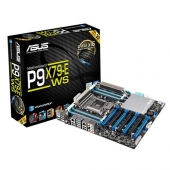 |
Features
- Intel® LGA 2011 platform/Intel® X79 chipset
- Quad Channel-8 DIMM
- Best Graphics Performance with 4-Way GeForce® SLI™ and CrossFireX™ x16 links
- Intelligent PSU Detection with ASUS Dr.Power
- Better networking with new dual server-grade Intel® I210 Ethernet
- High speed storage and data transfers with ASUS SSD Caching II
Specifications
| Supported CPUs | Intel® Socket 2011 Core™ i7 Processors Intel® Socket 2011 for Xeon® E5-1600/E5-1600 v2 processors Intel® Socket 2011 for Xeon® E5-2600/E5-2600 v2 processors Supports Intel® Turbo Boost Technology 2.0 |
| Chipset | Intel X79 |
| Memory | 8 x DIMM, Max. 64GB, DDR3 2400(O.C.)/2133(O.C.)/1866(O.C.)/1866/1600/1333/1066 MHz ECC, Non-ECC, Un-buffered Memory *1 Quad Channel Memory Architecture Supports Intel® Extreme Memory Profile (XMP) |
| Multi-GPU Support | Supports NVIDIA® 4-Way SLI™ Technology Supports AMD 4-Way CrossFireX Technology |
| Expansion Slots | 7 x PCIe 3.0/2.0 x16 (single x16 or dual x16/x16 or triple x16/x16/x16 or quad x16/x16/x16/x16 or seven x16/x8/x8/x8/x16/x8/x8, black+blue) |
| Storage | Intel® X79 chipset : 2 x SATA 6Gb/s port(s), white 4 x SATA 3Gb/s port(s), blue Support Raid 0, 1, 5, 10 Marvell® PCIe 9230 controller : 4 x SATA 6Gb/s port(s), white Support Raid 0, 1, 10 ASMedia® PCIe SATA controller : 2 x eSATA 6Gb/s port(s), red Support port multiplier support |
| LAN | Intel® I210, 2 x Gigabit LAN Controller(s) |
| Audio | Realtek® ALC1150 8-Channel High Definition Audio CODEC – Supports : Jack-detection, Multi-streaming, Front Panel Jack-retasking Audio Feature : – Absolute Pitch 192kHz/ 24-bit True BD Lossless Sound – DTS Surround Sensation UltraPC – Optical S/PDIF out port(s) at back panel |
| IEEE 1394 | VIA® 6315N controller 1 x IEEE 1394a port(s) |
| USB Ports | ASMedia® USB 3.0 controller : 4 x USB 3.0/2.0 port(s) (2 at back panel, blue, 2 at mid-board) Intel® X79 chipset : 13 x USB 2.0 port(s) (10 at back panel, black, 3 at mid-board) |
| Back I/O Ports | 1 x PS/2 keyboard/mouse combo port(s) 2 x eSATA 6Gb/s 2 x LAN (RJ45) port(s) 2 x USB 3.0 (blue) 10 x USB 2.0 (one port can be switched to USB BIOS Flashback) 1 x Optical S/PDIF out 8 x Audio jack(s) 1 x USB BIOS Flashback Button(s) |
| Form Factor | CEB Form Factor 12 inch x 10.5 inch ( 30.48 cm x 26.67 cm ) |
Packaging and Accessories
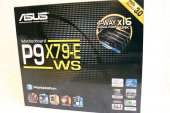 |
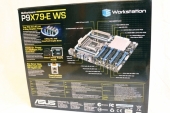 |
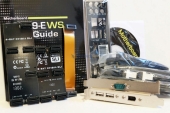 |
The P9X79-E WS comes in a pretty standard motherboard box. The front, back, and inside flap list the specs and key features along with large pictures of the board itself.
Aside from the motherboard itself ASUS includes a 4,3, and 2 way SLI bridge, rear serial expansion port, rear expansion USB/firewire card, 6 SATA cables, and a driver CD.
Closer Look
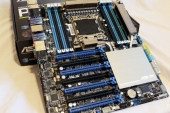 |
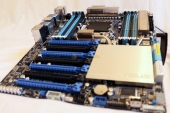 |
Let’s start with the most important part of any motherboard, the color. For this board Asus went with a black and blue theme which I think looks great and should fit in with most builds just fine.
As far as the overall layout goes, the P9X79-E WS has 8 RAM slots, 4 on either side of the CPU socket. With the RAM on the left and right and heatsinks on the top and bottom, I could see potential issues arising with some of the monstrous air coolers on the market right now so keep that in mind. The front panel connectors and processor 8-pin power are all in their standard places.
An auxiliary power connector is located just under the CPU socket to give you extra juice when you have multiple high-draw graphics cards installed.
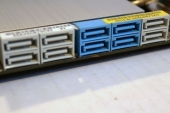 |
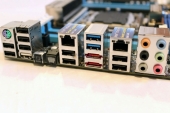 |
Along the front edge we have 10 SATA ports. The top 6 are for the built-in X79 chipset, the white ones being 6 Gbps and blue 3 Gbps. The 4 white ports next to them are 6 Gbps and connected to the Marvell controller.
On the back panel we have 10 USB 2.0 ports (from the X79 chipset), 2 USB 3.o (from the ASMedia controller), 2 eSATA 6Gbps ports, a PS2 port, 2 Gigabit ethernet ports, audio jacks, optical out, and a BIOS reset button.
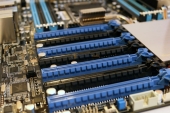 |
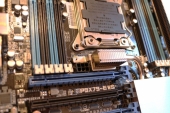 |
Other motherboards have 2 or 3 PCI-E slots, 4 if it’s a performance gaming board. This board has 7. Even in quad SLI/Crossfire, every single port will run at the full x16 speed. If you figure quad is still not enough, even if you fill all seven slots you will still run at x16/x8/x8/x8/x16/x8/x8. This is seriously impressive.
Along with 7 PCI-E slots you also get 8 RAM slots capable of running up to 64GB of quad channel memory.
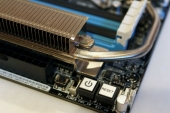 |
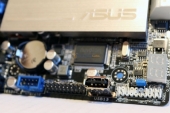 |
As many high-end motherboard do, the P9X79-E WS has a power and reset button right on the motherboard which is very handy for open air overclocking.
Another cool feature of this board is the USB port right on the motherboard which could prove useful in certain situations.
UEFI
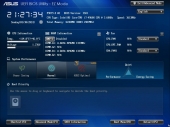 |
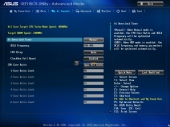 |
The UEFI for this board is pretty standard which means you spend less time trying to find things and more time trying to squeeze that last megahertz out of your chip. There is an “EZ mode” which gives you key info like temps, voltage, etc and allows you to do simple things like change boot order. The mode we are most interested in though is the “Advanced mode” where we have access to every possible adjustment available.
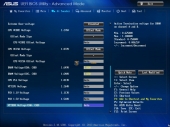 |
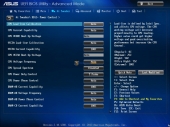 |
Between the advanced mode and our unlocked processor we are able to change just about any setting you could possibly need. The basics such as core ratio, base clock, core voltage, RAM timings, etc are all easy to find and allow for a wide range of adjustment. Digging further we can even get in to the minute tweaking details such as VCCSA voltage, load line calibration, etc. You won’t leave the BIOS thinking, “Man I wish there were more settings to tweak.”
Bundled Software
 |
Asus includes the AI software suite with the motherboard which includes multiple small widgets mainly related to monitoring your system and making small tweaks outside of the UEFI.
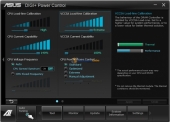 |
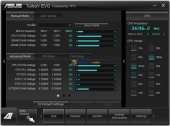 |
Of the bundled software, the two I found the most interesting were the Digi+ Power Control and TurboV EVO. Digi+ allows you to adjust CPU power settings without restarting and going through the UEFI. TurboV Evo is even more interesting in that it lets you adjust your base clock, core ratio, and all of the critical voltages on the fly.
Overclocking Performance
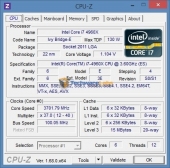 |
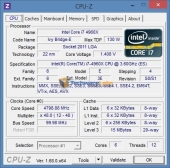 |
Of course with a high-end motherboard such as this one and the best desktop processor on the market, overclocking is bound to happen. So we pushed our chip as far as we felt comfortable and came out with some amazing results.
By just increasing the voltage and multiplier we were able to push our 4960X from the stock 3.6 GHz (with turbo pushing it a little higher) to a whopping 4.8 GHz stable at only 1.4 volts which is really impressive for this 6 core behemoth.
Finding and adjusting the necessary settings was simple with the straight-forward layout of the UEFI and we were able to push it up to its max with no headaches.
–~~~~~~~~~~~~–
Final Thoughts
Pros:
- Support for i7 and Xeon
- 7 PCI-E slots with support for 4-way at x16
- Plenty of USB and SATA ports
- Excellent overclocking performance
Cons:
- None
Overall, I was really impressed with the ASUS P9X79-E WS motherboard. You have the option to run either a desktop or server processor, giving you plenty of options as well as some “future-proofing” by letting you change to a completely different platform by only swapping the CPU. You also have tons of room to expand with an abundance of PCI-E slots that have the ability to run quad SLI/CrossFire at the full x16 speed as well as enough USB and SATA ports for as many devices as you will ever need. Finally, for the enthusiasts, you get awesome overclocking performance and the ability to tweak every possible setting you can think of in the UEFI. At $460 it is one of the most expensive socket 2011 motherboards available, but it is also the most feature rich and the only one that supports both i7 and Xeon.
If you are looking for a motherboard that can do it all from server duty to Call of Duty, the P9X79-E WS is in a class of its own.
 |

[…] ASUS P9X79-E WS Motherboard Review @ TechwareLabs […]